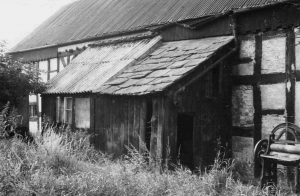Toad Hall
The ramshackle house that Alan Garner made his home, is a three bay timber-frame medieval hall, with very few structural modifications, and still barely modernised. It was the manorial home of the Eaton family, whose male line ended in 1664. The open hall was closed in the 17th century.
In about 1683 it became a farm, and remained a farm until about 1880 when it was converted into two tied cottages for farm labourers.
It remained as two cottages until 1957, when Alan Garner bought first one and then the other, complete with Closing Order, for a total of £670. There was no electricity and the occupant of the other cottage still used the earth closet in the garden.
The south west elevation of Toad Hall has been rebuilt in brick, but the surviving timber frame is of three bays within a box frame construction.
There are two inner raised cruck trusses, delineating the open hall, which is flanked by a cross passage and service bay on one side and by a parlour and great chamber on the other.
Tree-ring dating has shown that the whole is of one build, although since the only timber to give a date is a cruck blade that was inserted into the pre-existing frame no calendar date for the building as a whole can yet be apportioned. What we do know is that the replacement blade was felled in the winter of 1551/2.
The Eatons of Goostrey and Blackden failed in the male line in 1664 and the heiress married ‘Kinsey’ of Blackden. This resulted in the Kinsey family owning two halls, a quarter of a mile apart. Their existing hall had been built in 1590. The hall of the Eatons became the home farm, but, as in many analogues, would still have been referred to by the local population as ‘the old hall’. There is no difference in the phonetics of Cheshire dialect between ‘the old’ and ‘toad’. While this is an assumption, it is a logical explanation for the origin of the name.
 In about 1683, the open hall was closed in by the new tenant farmers, the Forsters, who formed a powerful and beneficent dynasty lasting over a century. Thereafter, the land was farmed by a series of families until, about 1880, it was reapportioned and the hall was divided into two tied labourers’ cottages. It remained as two cottages until 1957, when Alan Garner bought first one, and then the other, complete with Closing Order, for a total of £670. There was no electricity and the occupant of the other cottage still used the earth closet in the garden.
In about 1683, the open hall was closed in by the new tenant farmers, the Forsters, who formed a powerful and beneficent dynasty lasting over a century. Thereafter, the land was farmed by a series of families until, about 1880, it was reapportioned and the hall was divided into two tied labourers’ cottages. It remained as two cottages until 1957, when Alan Garner bought first one, and then the other, complete with Closing Order, for a total of £670. There was no electricity and the occupant of the other cottage still used the earth closet in the garden.
In 1968, Alan Garner’s novel, The Owl Service, was serialised by Granada Television, which generated the wherewithal to install a septic tank. The need to build a bathroom led to the rescue of The Old Medicine House.

